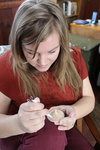
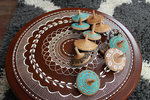
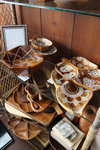
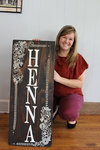
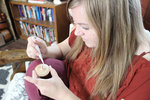
For many cultures throughout the world, henna artwork is something done during times of great joy and celebration.
Though it was not how she found the art form, Susan Clark said that is what henna has brought to her life.
“I love that it’s used in such a celebratory way by so many people. When I came to it through a really dark place,” Clark said.
Clark, owner of Suno Henna art company, began working in the impermanent artform in 2015 after she and her husband, Bradley, experienced the death of their second child. She said doing henna art allowed her a space to heal and sometimes to help heal others.
“Being able to do something beautiful and to be able to talk about him and his legacy is really wonderful,” Clark said.
Clark, of Chehalis, went to school in Mossyrock. She majored in art at a college in Seattle then spent a year abroad before returning to Lewis County. She taught art at a local high school for three years before her son, James, 6, was born. Art was a solace to the new mom as she struggled with a premature baby who cried almost nonstop until he was diagnosed with a dairy allergy.
“His whole first year is just a blur,” Clark said.
Then the family was dealt a huge blow when the Clarks were expecting their second child. An ultrasound detected that the baby had anencephaly, a disorder that meant he would not live long. Believing every life to have purpose, they decided to continue with the pregnancy and Graham Wheeler Clark was born on May 5, 2015, weighing five pounds. His parents got to spend five precious hours with him before he died.
“After he was born, I just wanted to hide,” Clark recalled.
Soon after losing Graham, Clark attended a wedding where she had a chance to visit with her aunt, who has been a professional henna artist for about 15 years. She said her aunt had encouraged her for years to try her hand at henna because of her artistic background and this time, urged her to try it for therapeutic reasons.
“Ultimately, it was my faith in God and my belief that he is in a better place that got me through that time but henna gave me a way to interact with people without being angry or sad,” Clark said.
Clark’s aunt taught her to mix the powdered henna, which comes from the Lawsonia inermis plant, with water and sugar to make just the right consistency to create designs on skin. Clark said she adds essential oils to her henna mixture such as lavender, tea tree oil and Cajeput to make the dye come out darker as well as cardamom because she likes the smell.
Clark cautioned that not all hennas are created equal and she encourages consumers considering getting henna artwork done on their body to ask about the product’s ingredients. Clark is insured for her henna work but artists who use so-called black henna cannot be insured. That is because their product contains a chemical used in hair dye that can easily react with the skin and cause burns. Real henna will be green when applied and darken to a reddish brown over time. Black henna will be dark immediately and will be black as the name implies. Clark said real henna also must be mixed fresh, so avoid artists who use pre-mixed henna or henna that has been sitting around a long time with no refrigeration.
“Real henna is like a food. It expires after three days and it’s not going to stain anymore,” she noted.
Clark noted that with real henna skin artwork, the artist’s work is only half of the design. For best results, she tells clients to leave the thick, dried henna paste on for at least four hours if possible and protect the design from water with coconut oil for the first day. Real henna will darken over the first 48 hours and can last one to four weeks depending on where the design is located and how often it is in contact with water.
Clark offers custom henna art at various fairs and festivals during the summer season and at one event each month in the winter months. Clients can pick specific designs from a book of Clark’s original artwork or they can choose to give her creative freedom to talk to them and try to give them a design she thinks reflects their style.
“You kind of get to know them in just a brief moment but they’re letting you do something that’s going to last on their skin for a while,” Clark said. “I had one lady at the cranberry festival in Ilwaco who was 64 and she said henna was on her bucket list. I thought, ‘well, cool’ and we got to experience that together.”
Though henna artistry is often associated with the mehndi painted on brides in India, Clark noted that is a tradition that is found in many countries. Clark said she also loves that it is even mentioned in the Bible. Each different region has its own specific style and symbolism for henna art and Clark said she studies and finds inspiration from all of them.
“For me, being in the U.S., it’s more of an amalgamation,” Clark explained of the inspiration behind her designs. “I don’t use a lot of the symbols unless somebody asks me specifically for them. I go mostly for aesthetics and the joy and celebration of it.”
And Graham Wheeler’s memory does indeed live on in Clark’s artwork. Through her work, she said she has met many other parents who have experienced the loss of a child. And she was recently invited to do henna artwork at a yoga retreat for parents who had experienced the death of a child.
“It was really cool and there was a lot of crying during that one,” Clark recalled. “It’s always a special thing to meet someone who knows what you’re going through.”
Last year, Clark also began offering her artwork in a more permanent form. Most of her henna clients are women and their husbands and boyfriends would often ask her if she had something for men or something they could take home. Recycling is important to Clark, so she had the idea to find wooden items at thrift stores and give them new life with a henna-inspired designs. She offers home décor items such as picture frames, bowls, plates, platters, candle sticks and wooden state outlines embellished with her artwork at events she attends as well as through online sales.
Believing in supporting other local artists and businesses, Clark also paints bowls, plates and toy tops made by local wood turner Cole Zandell. She noted that she also uses lavender essential oil from Cowlitz Falls Lavender in Randle.